Elizabeth Charlotte, Madame Palatine
Princess Elisabeth Charlotte[2] (German: Prinzessin Elisabeth Charlotte von der Pfalz; known as Liselotte von der Pfalz, 27 May 1652 – 8 December 1722) was a German princess member of the House of Wittelsbach and, as Madame (Duchesse d'Orléans), the second wife of Philippe I, Duke of Orléans (younger brother of Louis XIV of France), and mother of Philippe II, Duke of Orléans, France's ruler during the Regency. She gained literary and historical importance primarily through her correspondence, which is of cultural and historical value due to her sometimes very blunt descriptions of French court life and is today one of the best-known German-language texts of the Baroque period.
| Princess Palatine Elisabeth Charlotte | |
|---|---|
| Duchess of Orléans | |
.jpg.webp) Portrait by Hyacinthe Rigaud, ca. 1713. Currently displayed at Versailles Palace. The black veil is the customary widow's veil, the hermelin-lined coat with golden Fleur-de-lis on a blue background distinguishes her as a member of the French royal family.[1] | |
| Born | 27 May 1652 Heidelberg Castle, Heidelberg, Electoral Palatinate, Holy Roman Empire |
| Died | 8 December 1722 (aged 70) Château de Saint-Cloud, Île-de-France, Kingdom of France |
| Burial | Basilica of Saint Denis, France |
| Spouse | |
| Issue Detail | |
| House | Palatinate-Simmern (by birth) Bourbon (by marriage) |
| Father | Charles I Louis, Elector Palatine |
| Mother | Landgravine Charlotte of Hesse-Kassel |
| Religion | Roman Catholicism prev. Calvinism |
| Signature | |
Although she only had two surviving children, she not only became the ancestress of the House of Orléans, which came to the French throne with Louis Philippe I, the so-called "Citizen King" from 1830 to 1848, but also became the ancestress of numerous European royal families, so she was also called the "Grandmother of Europe".[3] Through her daughter she was the grandmother of Francis I, Holy Roman Emperor, the husband of Maria Theresa, and great-grandmother of Joseph II and Leopold II (both Holy Roman Emperors) and Marie Antoinette, the last Queen of France before the French Revolution.
Life
Early years
Elisabeth Charlotte was born on 27 May 1652 in the castle of Heidelberg as the second child and only daughter of Charles I Louis, Elector Palatine, and his wife Charlotte of Hesse-Kassel. Named after her paternal grandmother Elizabeth Stuart and her own mother, from a young age she was nicknamed Liselotte, a portmanteau of both her names. She was at birth very weak and thin, so an emergency baptism was performed upon her. She first grew up in the Reformed Protestant faith, the most widespread denomination in the Electoral Palatinate at that time.[4]
Liselotte was a lively child who liked to run around and climb trees to nibble on cherries;[5] she sometimes claimed that she would have preferred to be a boy, and referred to herself in her letters as "wild child" (rauschenplattenknechtgen).[6]
The marriage of Liselotte's parents soon turned into a disaster and domestic violent scenes were the order of the day.[7] In 1657, Elector Charles I Louis separated from his wife Charlotte in order to marry morganatically with Marie Luise von Degenfeld, who thus became Liselotte's stepmother. Liselotte probably perceived her as an intruder,[8] but was known that she loved at least some of her 13 half-siblings, the Raugrafen. With two of her half-sisters, Louise (1661–1733) and Amalie Elisabeth, called Amelise (1663–1709), she kept a lifelong correspondence. Her half-brother Charles Louis (1658–1688), called Karllutz, was a particular favorite of hers; she also called him "Black Head" (Schwarzkopfel) because of his hair color and was ecstatic when he later visited her (1673) in Paris.[9][10] His early death in battle deeply saddened her.
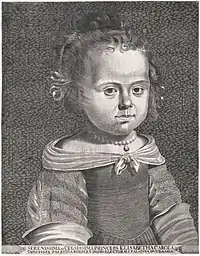

The most important caregiver in Liselotte's life was her aunt Sophia of the Palatinate, her father's youngest sister, who also lived in Heidelberg Castle with Charles I Louis until her marriage in 1658 with Ernest Augustus, Duke of Brunswick-Lüneburg.[12][13] In order to deprive Charlotte of her daughter,[14] in 1659 Liselotte was sent by her father to her aunt's court in Hanover; she later remembered this time as the happiest of her life.[15] Sophia became in a motherly figure for her niece, and remained her most important confidante and correspondent throughout her life.[16] During this time she also took a total of three trips to The Hague, where Liselotte could meet her paternal grandmother Elizabeth Stuart, the "Winter Queen" of Bohemia, who was still living in exile.[17][18] Although in general she didn't particularly love children, she became very fond of her granddaughter, whom she found resembled to her own family, the Stuarts: "She is not like the House of Hesse...she is like ours".[19] Her relatives in The Hague also included the slightly older William of Orange-Nassau, who was her playmate and was later to become King of England.[20] She later also remembered the birth of Sophia's son George Louis, who also became King of England.[21] As early as 1661, Liselotte knew French so well that she got a French woman named Madame Trelon, who did not understand German, as a governess.[22] When Duke Ernest Augustus of Brunswick took office as Prince-Bishop of Osnabrück in September 1662, Liselotte moved with her foster parents to Iburg Castle.[23]
In 1663 Elector Charles I Louis granted Liselotte's mother Charlotte adequate monetary compensation, who then left the Heidelberg residence. Immediately afterwards the Elector brought his daughter back to the court in Heidelberg, where she received visits from her aunt Sophia a few more times. Liselotte now received a courtly education, which was customary for princely houses at the time, which, in addition to French lessons, dancing, playing the spinet, singing, handicrafts and history, consisted above all in the fact that she was regularly read from the Bible “in two languages, German and French”. Her new governess, Maria Ursula Kolb von Wartenberg, called "the Kolbin", on whom she played some pranks, would also make sure that she should not be caught in "any hatred or prejudice against someone because they belong to a different religion".[24] The last point was quite unusual in its time and was based on the relatively free convictions of her father Charles I Louis, who was a Calvinist himself, but had a built in Mannheim a Concordia church (Konkordienkirche), which the followers of the Calvinist (or Reformed), Lutheran and Catholic denominations could celebrated their rituals.[4][25] Liselotte benefited from this relatively open religious attitude throughout her life; she had already got to know the Lutheran denomination at court in Hanover and decades later she knew how to sing Lutheran chorals by heart.[26] Before her marriage, she had to convert to the Catholic faith for dynastic reasons; however, throughout her life she remained skeptical of any dogmatism and often expressed herself critically about “the priests”, even if she went to mass every day;[27] she was always convinced of the Calvinist doctrine of predestination; every morning she read a section in the Lutheran Bible and also criticized the veneration of the saints.[28]
From her youth in Heidelberg, her first stable master and steward, Etienne Polier, became a confidante, whom she took with her to France after her marriage and who remained in her service for life.[29]
Marriage

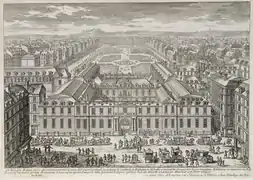
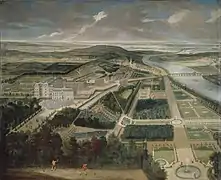
For political reasons, Liselotte was married in 1671 to the brother of King Louis XIV of France, Philippe I, Duke of Orléans, known as "Monsieur". In the Ancien Régime this title belonged to the King's eldest brother. Described in her marriage contract as "the Electoral Princess Palatine of the Rhine" (Kurpfalzprinzessin), as wife of the Duke of Orléans, Liselotte assumed the style of Madame.[30][31][32] This union was conceived by Anna Gonzaga, Liselotte's aunt (as widow of Edward, Count Palatine of Simmern, Charles I Louis' younger brother) and an old friend of the Duke of Orléans; she not only negotiated the marriage contract, including the secret Catholic instruction and subsequent public conversion of the fiancée but also escorted Liselotte from Heidelberg for Paris. The wedding per procurationem took place on 16 November 1671 at the Cathedral of Saint Stephen in Metz by Bishop Georges d'Aubusson de La Feuillade; in representation of the groom was the Duke of Plessis-Praslin.[33] The day before, she had already solemnly renounced her old Reformed faith and converted to the Roman Catholic faith.[34] She saw her husband, who was 12 years her senior, for the first time on 20 November 1671 in Châlons.[35]
Monsieur didn't look ignoble, but he was very short, had pitch black hair, eyebrows and eyelids, big brown eyes, a long and rather narrow face, a big nose, a mouth that was too small and ugly teeth more feminine than man's manners, loved neither horses nor hunting, nothing but games, holding cercle, eating well, dancing and being dressed, in a word, everything that ladies love. ... The King loved gallantry with ladies, I do not believe that my husband has been in love in his life.
— Liselotte von der Pfalz: Letter to Caroline, Princess of Wales from 9 January 1716 about her husband Philippe, called Monsieur.[36][37][38]
Outwardly, Liselotte led a glamorous life from then on and had (until his death in 1701) her own apartments in her husband's residences, the Palais Royal in Paris, and the Château de Saint-Cloud.[39] However, the couple lived mostly at the royal court, where they had to be present for about three quarters of the year, first in the Château de Saint-Germain-en-Laye and, after its completion in 1682, in the Palace of Versailles, where they had two adjacent apartments in the main wing. They also had apartments in the Palace of Fontainebleau, where the court went in autumn for the hunting season, in which Liselotte (who unlike her husband) took part with enthusiasm. She often rode with the King through the woods and fields all day long, from morning to night, without being deterred by occasional falls or sunburn.[40][41] From Fontainebleau, the couple made regular detours to Montargis Castle, which belonged to Monsieur and which, according to their marriage contract, would later fall to Madame as a (hardly used) widow's seat.[42] Liselotte had her own court of 250 people, which cost 250,000 livres annually, while her husband had an even larger one.[43]
For the Duke of Orléans it was already his second marriage, his first wife and cousin Henrietta of England died suddenly and under mysterious circumstances in 1670. He also brought two daughters into his new marriage, 9-year-old Marie-Louise (with whom Liselotte was able to build a warm, but rather sisterly relationship[44]), and 2-years-old Anne Marie (who had no memory of her birth mother and whom Liselotte loved like her own child[37]).
Liselotte and Philippe's marriage was problematic for both sides, as he was homosexual and lived it out quite openly.[45][46][47][48] He led a largely independent life, together with and influenced by his main and long-time lover, the Chevalier de Lorraine;[49] he also had other favorites and numerous smaller affairs with younger men, which the Chevalier himself and one of his friends, Antoine Morel de Volonne (whom Monsieur made Liselotte's Hofmarschall during 1673–1683[50]) procured to him. Morel had a very bad reputation even by the standarts of the time: "He stole, he lied, he swore, was atheist and sodomite and sold boys like horses."[50]
Philippe fulfilled his marital duties rather reluctantly, he didn't want to be hugged by Liselotte if possible[51] and even scolded her when she accidentally touched him in his sleep.[52] After he fathered with her three children, in 1676 he finally ended their sexual relationships, to Liselotte's relief and with her consent.[53]
Liselotte had no choice but to come to terms with these conditions, and she ultimately became an unusually enlightened woman for her time, albeit in a somewhat resigned way:
Where have you and Louisse got stuck that you know them so little? (...) if you hate everyone, so love young guys, you wouldn't be able to love 6 people here [...] there are all kinds of genres; [...] (This is followed by a list of various types of homo and bisexuality, as well as pederasty and sodomy, editor's note) [...] You tell, dear Amelisse, that the world is even worse than you never thought.
Her most important biographer, the historian and Antwerp professor of French baroque literature Dirk Van der Cruysse, judges: “She was providentially placed between two completely dissimilar brothers, of whom the older made up for the fundamental inability of his younger brother through his appreciation and friendship: to love anyone other than herself. She showed her affection to both of them, wholeheartedly and without any ulterior motives, and accepted the overwhelming power of the one as well as the Italian inclinations of the other without complaint, as destined by fate."[56]
At the court of Louis XIV
_in_hunting_dress_%E2%80%93_Elle_(1673).jpg.webp)
Liselotte got on very well with her brother-in-law Louis XIV. He was "...enchanted by the fact that this was an extremely witty and lovely woman, that she danced well..."[57] (the King himself was an excellent dancer and appeared in ballets by Lully), and he was quite amused by her open, humorous and refreshingly uncomplicated nature. A friendship soon developed between them and they often went hunting together —a rather unusual occupation for a noble lady of the time.[58][59] Her desire to go for a walk was also noticed at the French court and was initially laughed at somewhat (she even went for a walk in the park at night[60]) but the King was delighted: "Whether Versailles has the most beautiful rides, nobody drove and went for a walk but me. The King used to say: il n’y a que Vous qui jouissés des beautés de Versailles (you are the only one who enjoys the beauties of Versailles)".[61] She also shared with Louis XIV a preference for theater of all stripes[62] and was also aware that she was allowed to experience a high point of French culture:
When I came to France, I got to know people who will probably not be around for centuries. There were Lully for the music; Beauchamp for the ballet; Corneille and Racine for tragedy; Molière for comedy; the Chamelle and the Beauval, actresses; Baron, Lafleur, Torilière and Guérin, actors. All of these people were excellent in their field ... Everything you see or hear now does not match them.
Although she was not particularly beautiful (an important asset at the French court) and was somewhat unconventional by the current standards, Liselotte also made a very good impression on the courtiers and witty Parisian salon ladies. They originally had prejudices and expected a 'rough' and 'uncultivated' foreigner. In reference to Queen Maria Theresa, who never really learned to speak French and was too good-natured for the malicious jokes of the Précieuses, Madame de Sévigné had previously mocked ironically: "What a delight to have a woman again who can't speak French!"; but after she got to know Liselotte, she noticed a “charming directness” in her and said: "I was amazed at her jokes, not at her lovable jokes, but of her common sense (esprit de bon sens)...I assure you to you that it cannot be expressed better. She is a very idiosyncratic person and very determined and certainly has taste."[63] Madame de La Fayette was also positively surprised and made very similar comments about Liselotte's esprit de bon sens.[63] The King's cousin La Grande Mademoiselle at first said: "When you come from Germany you don't have a French way of life", but later recalled: "It made a very good impression on us, but Monsieur didn't think so and was a little surprised. But when she pretended to be French it was something completely different."[64] When the Electress Sophia and her daughter visited Liselotte in Paris and Versailles in 1679, she stated: "Liselotte...lives very freely, and with more fully innocence: her cheerfulness cheers up the King. I have not noticed that her power goes further than making him laugh, nor that she tries to carry it further."[60]
In France, Liselotte only had two German relatives, two older aunts, with whom she had regular contact: Louise Hollandine of the Palatinate (a sister of her father and Abbess of Maubuisson since 1664) and Emilie of Hesse-Kassel (a sister of her mother, who had married the Huguenot general Henri Charles de La Trémoille, Prince of Taranto and Talmont). In her household where relevant Catherine Charlotte de Gramont (by marriage Princess of Monaco), who exercised the office of her mistress of the Robes, but died in 1678, as well as her lady-in-waiting Lydie de Théobon-Beuvron.[65]
Children
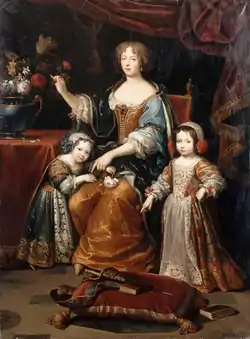
Liselotte and Philippe I of Orléans had three children together:
- Alexandre Louis d'Orléans, Duke of Valois (2 July 1673 – 16 March 1676). Born at the Château de Saint-Cloud and died at the Palais-Royal before his third birthday, his death being attributed to the bloodletting by the Orléans family's doctors; last person to carry the title Duke of Valois.[66]
- Philippe d'Orléans (2 August 1674 – 2 December 1723). Born at the Château de Saint-Cloud, he was titled Duke of Chartres from birth until becoming Duke of Orléans in 1701; married his first cousin Françoise Marie de Bourbon and had issue; died at the Palace of Versailles; Regent of France and Navarre during the minority of Louis XV of France—the era was known as la Régence.
- Élisabeth Charlotte d'Orléans (13 September 1676 – 23 December 1744). Born at the Château de Saint-Cloud and married Leopold, Duke of Lorraine in 1698 and had issue; became the Sovereign Princess of Commercy 1737; she died at Commercy; known as Mademoiselle de Chartres, a title given her at birth; grandmother of Queen Marie Antoinette.
Liselotte had a warm relationship with her children and the untimely death of her eldest son Alexandre Louis at the age of two was a very hard blow for her. She mourned him for six months before the birth of her daughter, who apparently helped her over the terrible loss.[67]
I do not think that one can die out of excessive sadness, because otherwise I would without a doubt go on it, because what I felt in myself is impossible to describe.
— Liselotte von der Pfalz: Letter to Anna Katharina von Offen from April 1676 about the death of her first son.[67]
Her younger son Philippe not only looked like her outwardly, but shared her literary, artistic and scientific interests; during his father's lifetime and shortly thereafter, his relationship with his mother was distant, as his father and his favorites influenced him and allowed him everything, while his mother criticized his debauchery. Later, however, their relationship improved and in the end they were very close, which was not exactly common in royal houses at the time.
Difficulties and tragedies
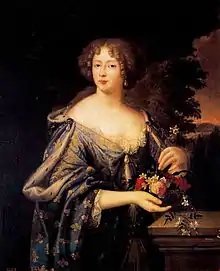
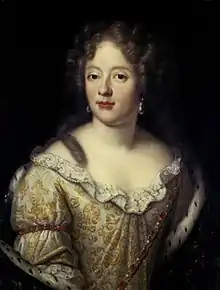
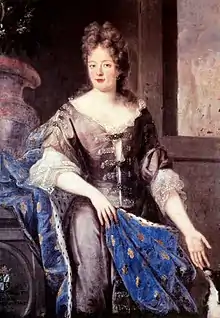
_being_attended_to_by_a_slave_by_Fran%C3%A7ois_de_Troy.jpg.webp)
From around 1680 massive problems arose, as the Chevalier de Lorraine, the Marquis d'Effiat and other favorites of her husband incited him more and more against Liselotte and intrigued against her in order to eliminate her influence on Monsieur.[68] She was the victim of extreme harassment, and her marital relationship was now completely shattered. Among other things, her enemies used slander to get some of her confidants, including the lady-in-waiting Lydie de Théobon-Beuvron —whom she loved—, to be dismissed and banished from court, including her husband, the Chamberlain Count de Beuvron, and the Baron de Beauvais. After these departures she was exposed to the intrigues of the favorites and the arbitrariness of her husband almost defenseless, especially since at the same time her personal relationship with the King cooled down when his mistress Madame de Maintenon gained influence,[69] and Louis XIV was less and less inclined to intervening in Liselotte's favor against her husband. The intrigues led to the isolation and disappointment of Liselotte, who now withdrew more and more into her writing room.[70]
Monsieur...has nothing in the world on his mind but his young boys to eat and drink with them all nights and gives them unheard-of sums of money, nothing costs him nor is too expensive in front of his boys; meanwhile, his children and I hardly have what we need.
— Liselotte von der Pfalz: Letter to Duchess Sophia of Hanover from 7 March 1696.[71]
Simultaneously with Liselotte's domestic problems, French nobles and courtiers had formed a secret homosexual 'brotherhood' which required those who joined her to "swear an oath to renounce all women";[72] the members are said to have carried a cross with a relief on which a man "kicks a woman into the dust" (in an unholy allusion to the Archangel Michael).[73] The Duke of Orléans didn't belong to this brotherhood, but many of his favorites were. Indeed, some courtiers in Paris behaved scandalously and several incidents were reported in which women were sadistically tortured,[74] and also was reported that a poor waffle seller was raped, castrated and killed by courtiers.[75][76] When it became known that the 'brotherhood' also included the Prince of la Roche-sur-Yon and the Comte of Vermandois (one of the King's legitimate sons with Louise de La Vallière), in June 1682 became a wave of exiles. Louis XIV punished his own son very severely and sent him to war, where he died shortly afterwards at the age of 16.[77][78] Liselotte was directly affected by this incident, since the Count of Vermandois was her ward after his mother leave the court to become a nun; she recalled: "The Comte de Vermandois was very good-natured. The poor person loved me as if I were his birth mother. ... He told me his whole story. He had been horribly seduced."[79] One of his 'seducers' is said to have been the Chevalier de Lorraine —her husband's lover and her avowed enemy.[79]
Other problems arose in the following years for Liselotte, as she harbored a massive aversion to Madame de Maintenon, the last important mistress and from the end of 1683 the secret wife of Louis XIV, whom she increasingly controlled him. Liselotte couldn't accept the social position and the lust for power of this woman (the widow of a playwright, who rose from difficult circumstances[80][81]) and described her in numerous letters with epithets like "the King's old drab", "old whore", "old witch", "Megaera", "Pantocrat" or as "mouse filth mixed with the peppercorns".[82][83][84] At the instigation of the Maintenon, Liselotte's contacts with her brother-in-law were restricted to formal occasions, and if the King retired to his private apartments with some chosen relatives after dinner, she was no longer admitted. In 1686 she wrote to her aunt Sophia: "Where the devil can't get there, he sends an old woman, whom we all want to find out, being part of the royal family.."[85] and in 1692: "What an executioner We wanted to take our old rumpompel away, should I think he was an honest man and would like to ask him to be ennobled".[86] Since their correspondence was secretly monitored, the King and the Maintenon found out about this and this, of course, had an adverse effect on Liselotte's once good contact with Ludwig.
In addition, since 1680 —after the Affair of the Poisons, in which the previous maîtresse-en-titre Madame de Montespan was involved– Louis XIV underwent a change, and under the influence of the bigoted Madame de Maintenon, he became from a former philanderer who was primarily interested in his pleasure and not infrequently crept into the apartments of Liselotte's maid of honor, into a man who suddenly preached morality, piety and religion.[87] herefore, he issued the Edict of Fontainebleau in 1685, with which he ended the religious tolerance of the Edict of Nantes and a renewed persecution of the Huguenots, many of them emigrated to Holland and Germany, including Liselotte's aunt Emilie of Hesse-Kassel. The emigrants were supported by the Brandenburg ambassador, Ezekiel Spanheim, with advice and action; Liselotte was very close to him because he had once been the tutor of both her father and brother.[88] Since Liselotte herself was originally a Reformed, i.e. Huguenot, and (in contrast to the even half Huguenot Maintenon) had only become a half-hearted Catholic (or more precisely: a woman who had a very free attitude towards religion) this was originated for her problematic situations, and she later wrote to her aunt Sophia: “Had this been done, as I was at Heydelberg 26 years ago, EL [=her lover, author's note] would never have wanted to persuade me to became a Catholic".[89] The guilt for all this and for the bigotry of the King was primarily not attributed to him, but to the influence of Madame de Maintenon, who she regarded as hypocritically bigoted, greedy for power and corrupt and who hated anyway:[90]
The King...didn't know a word about our Bible; he had never been allowed to read it; said that if he only listened to his confessor and talked about his Pater Noster, everything would be fine and he would be completely godly; I often complained about it, because his intention has always been sincere and good. But he was made to believe, the old witch and the Jesuits, that if he would plague the Reformed, that would replace the scandal with god and people, as he did with the double adultery he committed with the Montespan. That's how you betrayed the poor gentleman. I have often told these priests my opinion about it. Two of my confessors, pére Jourdan and pére de St. Pierre, agreed with me; so there were no disputes.
— Liselotte von der Pfalz: Letter to her half-sister Raugräfin Luise from 9 July 1719.[91]
At the royal court, however, the topic was taboo:
EL [her lover] are right to say that one does not talk about the agony here if one does the poor Reformed, one does not hear a single word about it. On what EL say about this, EL can surely think that I am not allowed to say anything, but the thoughts are duty-free; but i have to say that whatever IM (Her Majesty) may be saying on this, don't believe anything if it's mad. The Maintenon, nor does the Archbishop of Paris say; only the King believes in them in religious matters.
— Liselotte von der Pfalz: Letter to Duchess Sophia of Hanover from 10 October 1699.[92]
Liselotte, however, also saw the opportunities that the Huguenots had to emigrate to the Protestant countries:
The poor Reformed ... who settled in Germany will make the French common. Colbert is said to have said that many are subjects of kings and princes wealth, therefore wanted everyone to marry and have children: so these new subjects of the German electors and princes will become wealth.
— Liselotte von der Pfalz: Letter to Duchess Sophia of Hanover from 23 September 1699.[92]
When the Wittelsbach line of Palatinate-Simmern ended in 1685 with the death of Liselotte's brother, Charles II, Elector Palatine, Louis XIV raised a claim to the Electoral Palatinate on behalf of Liselotte, contrary to her marriage contract, and began the Palatinate War of Succession. Heidelberg (including the electoral palace) and Mannheim, were systematically destroyed. For Liselotte, who at the same time also had to cope with the death of her beloved half-brother Karllutz, this was probably the most traumatic time of her life. She suffered a lot from the devastation of her homeland and from the fact that this officially also happened in her name:
...as soon as I had recovered a little from poor Karllutz's death, the terrible and pathetic misery in the poor Palatinate began, and what hurts me most about it is that my name is used to plunge poor people into utter misfortune...[93]So I can not help but regret and weep that, so to speak, I am the downfall of my homeland...[94]
— Liselotte von der Pfalz: Letter to Duchess Sophia of Hanover from 20 March 1689.
This situation inevitably brought her into a strong inner conflict with the King and his inner circle, which, to make matters worse, often reacted with naive incomprehension:[95][96]
...every night, as soon as I fall asleep a little, it seems to me that I am at Heidelberg or Manheim and you see all the devastation, and then I can't go back to sleep in two whole hours; then I can remember how everything was in my time, in what state it is now, yes, in what state I myself am, and then I can't refrain from "flennens" (crying, author's note)...and what's more, you don't feel bad that I'm sad about it, but I can't let it go...
Her husband Philippe generously distributed the spoils of war that fell on him (the so-called Orléans money) to his favorites, in particular to the Chevalier de Lorraine.[99]
In 1692 Liselotte had to see that her powerlessness extended to her own children: Louis XIV married her son Philippe, Duke of Chartres against her will to Françoise Marie de Bourbon, one of his illegitimate but legitimized daughters whom he had with Madame de Montespan.[100] The King also married his other "bastards from double adultery" within his family, because they couldn't have marry off to foreign courts, hardly even to the high nobility in France, and he saw that they could be married "under class" as unworthy of them. Liselotte and the courtiers viewed this marriage as a mésalliance and humiliation. Therefore, she reacted with indignation and anger. Various chroniclers report that she no longer had her emotions under control, burst into tears of desperation in front of the whole court,[101] and Saint-Simon writes that she slapped her son in front of the whole court because he had consented to the marriage have consented.[102] The wedding took place on 18 February 1692. The King gave his daughter a pension of 50,000 écus and jewelry worth 200,000 écus, but also a two million dowry was promised in the marriage contract, who at the end was never been paid.[102] This forced marriage was not a happy one either, and Philippe would have affairs with other women all his life.[103]
In 1693 Elisabeth Charlotte fell ill with life-threatening pox (smallpox). For fear of infection, the King and almost the entire court fled. She defied the instructions and ideas of contemporary doctors and survived the disease, but kept a pockmarked face. She didn't get upset about it, since she had always considered herself ugly anyway (in excessive exaggeration, as earlier portraits by Mignard and Largillière, among others, prove) and had no interest in beauty care or make-up. Possibly as a further consequence of the disease, from 1694 onwards she gained much weight,[104][105][106] that it interfered with their walks. Even so, she continued to hunt, but only mounted horses that were big and strong enough to support her weight.[105] The external change in her appearance can also be clearly seen in the surviving portraits, for example, in a painting by Antoine Dieu of the wedding of the Duke of Burgundy to Marie Adélaïde of Savoy on 7 December 1697, where on the right behind Monsieur a fat Liselotte stands, surrounded by ladies-in-waiting and her son.
In September 1700 she complained to her aunt Sophia: "Being a Madame is a great craft, I would have sold it like the batches here in the country, I would have long since carried it for sale".[107] Sophia, who grew up in relatively modest circumstances in exile in Holland, commented on her niece's lamentations in a letter to her (rather poor) half-brother Karllutz:
Madame too has her worries, but in the position of being in where she is, she has enough to console herself with.
— Letter from Duchess Sophia of Hanover to her nephew Raugraf Karllutz from 16 August 1687.[108]
As Sophia in the spring of 1701 by the Act of Settlement was declared heir to the British throne, Liselotte (who would have had a better claim if she hadn't become Catholic) commented on 15 May in a letter to her half-sister Raugräfin Luise: "I would rather be elector than king in England. The English humor[109] and their parliament are not my business, my aunt is better than me; she will also know how to deal with them better than I would have done".[110]
Widowhood
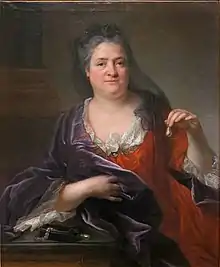
On 9 June 1701, Monsieur died of a stroke at the Château de Saint-Cloud. Earlier, he had a heated argument with his brother at the Château de Marly about the conduct of his son —who was also the Louis XIV's son-in-law. He only left debts, and Liselotte wisely renounced to their common property.[111] In his will, which was published publicly in the Mercure galant and the Gazette d’Amsterdam, he didn't mention them with a single word.[112] Liselotte personally burned the love letters he had exchanged with his lovers so that they would not fall into the hands of the notaries: "...in the boxes I looked up all the letters the boys wrote to him, and then spent them unread it might not come into contact with others".[113] She wrote to her aunt Sophia: "I must confess that I was much more saddened than I am if Monsieur had not done so böße officien (that is, 'bad services') to the King and always did so much worthless boys preferred to let me...".[114] Her attitude towards the deceased's mignons was no longer prudish, but rather serene: when she was reported in 1702 that the Earl of Albemarle, lover of the recently deceased King William III of England, almost died of heartache, she remarked dryly: "We have not seen such friends here with my lord...".[115]
After her husband's death, Liselotte feared that the king would send her to a convent (as stipulated in her marriage contract), so she made an attempt at reconciliation between Liselotte and Madame de Maintenon and the King.[116] To this she explained frankly and freely: "If I hadn't loved you, then I would not have hated Madame de Maintenon so much, precisely because I believed she was robbing me of your favor".[117] Madame de Maintenon then confronted Liselotte with secretly-made excerpts of her all-too-candid letters to correspondents abroad, which were bursting with abuse from the mistress, and read them with relish in foreign courts.[118] Liselotte was warned to change her attitude towards Madame de Maintenon,[30][32] but the harmony between the two women didn't last very long either, and Liselotte was "more tolerated than loved" after initial benevolence.[119] Except on official occasions, she was only rarely admitted to the King's inner circle. She was punished with contempt above all by Marie Adélaïde of Savoy, Monsieur's granddaughter from his first marriage and granddaughter-in-law of Louis XIV, who was a spoiled child, but an outspoken favorite of both the monarch and his mistress.
After Monsieur's death, Liselotte lived in his former apartment in Versailles and took part in visits to the court in Marly or Fontainebleau, where she also had her own apartments. At least she was allowed to take part in the court hunts, in which she and the king no longer sat on horseback, but sat together in a calash from which they shot, chased dogs or raised falcons. From then on Lieselotte avoided the Palais Royal and Saint Cloud until 1715 in order not to be a burden to her son and his wife. Her somewhat remote widow's residence, Montargis Castle, valued her little and rarely went to him; but she kept it in case the King should grow tired of her presence at Versailles, which the Maintenon endeavored to work towards:[120]
...she does every day (Madame de Maintenon) abrupt to me, have the bowls I want to eat taken away from my nose at the King's table; when I go to her, she looks at me through an axel and says nothing to me or laughs at me with her ladies; The old woman ordered that express, hoping I would get angry and amport myself so that they could say they couldn't live with me and send me to Montargis. But I notice the farce, so just laugh at everything you start and don't complain, don't say a word; but to confess the truth, so I lead a miserable life here, but my game is settled, I let everything go as it goes and amuse myself as best I can, think: the old one is not immortal and everything ends in the world; they won't get me out of here except through death. That makes you despair with evil...
— Liselotte von der Pfalz: Letter to her aunt Sophia of Hanover from 20 September 1708.[121]
The Régence. Death
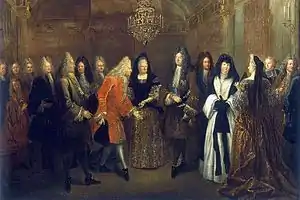
Louis XIV died on 1 September 1715 after a reign of 72 years and 110 days; one of the last people he summoned to his deathbed was Liselotte, saying goodbye to her with noble compliments. In his will, the deceased monarch divided the regnal prerogatives among relatives and courtiers, allocating to his legitimised son, the Duke of Maine, guardianship of the new monarch, Louis XV, who was 5 years old. The Parlement of Paris overturned the will's provisions at the request of Liselotte's son, Philippe II, Duke of Orléans, who, being the only legitimate agnate of the royal family in France, became in the Regent of the Kingdom for the still underage sovereign, beginning the time known as the Régence. Now, Liselotte became in the first lady of the court; she had been at least officially once before, between the death of Maria Anna Victoria of Bavaria, Dauphine of France (20 April 1690) and the marriage of Marie Adélaïde of Savoy with Louis, Duke of Burgundy (7 December 1697).
The court at Versailles dissolved until the new King came of age, as the late Louis XIV had ordered, and Liselotte was soon able to return to her beloved Saint-Cloud, where she from then on spent seven months of the year, with her old ladies-in-waiting keeping her company: the "Marschallin" Louise-Françoise de Clérambault and the German Eleonore von Venningen (by marriage von Rathsamshausen). She didn't like to spend the winter in the Palais Royal (the official residence of her son and his family) because of the bad Parisian air from the smoke from many chimneys (and "because in the morning you can only smell empty night chairs and chamber pot") and the bad memories of her marriage:
Unfortunately I have to go back to morose Paris, where I have little rest. But one must do one's duty; I am in the Parisian grace that it would sadden you if I should no longer live there; must therefore sacrifice several months for the good people. They deserve (it) from me, prefer me to their born princes and princesses; they curse you and give me blessings when I drive through town. I also love the Parisians, they are good people. I love it myself that I hate your air and home so much.
— Liselotte von der Pfalz: Letter to her half-sister Raugräfin Luise from 28 November 1720.[122]
Although she had made it her pattern not to interfere in politics,[123] only one month after the Louis XIV's death, Liselotte successfully campaigned for the release of Huguenots who had been sent on the galleys for many years because of their beliefs:[88][124] 184 people, including many preachers, were released; two years later she managed to get 30 galley prisoners released again.
However, Liselotte didn't feel the sigh of relief that went through the country after the long rule of Louis XIV; she "was unable to decipher the signs of the times; she saw nothing but the decline and decline of morality, where in reality a new society was born, lively, disrespectful, eager to move and live freely, curious about the joys of the senses and the adventures of the spirit".[125] For example, she strictly refused to receive visitors who were not properly dressed in courtly regalia:
Because the ladies cannot resolve to wear body pieces and to lace up...over time they will pay dearly for their laziness; because compt once again a queen, you will all have to be dressed like before this day, which will be an agony for you; - "You don't know anymore what was farm"...there is no more farm in all of France. The Maintenon invented that first; because, as she saw that the King didn't want to declare her before the queen, she had the young Dauphine (prevented) to hold a court, as keep yourself in your chamber where there is neither rank nor dignity; yes, the princes and the Dauphine had to wait for this lady at her toilet and at the table on the pretext that it was going to be a game.
Most of all, Liselotte was worried about the intrigues and conspiracies against her son. She loathed the foreign minister and later prime minister, Father Guillaume Dubois (cardinal from 1721); she mistrusted the economist and chief financial controller John Law, who caused a currency devaluation and speculative bubble (the so-called Mississippi bubble):
I wanted this Law to come to Blockula with his art and system and never come to France.
— Liselotte von der Pfalz: Letter to her half-sister Raugräfin Luise from 11 July 1720.[128]
As a clergy advisor, she valued two staunch supporters of the Age of Enlightenment: Archbishop François Fénelon (who fell from grace under Louis XIV) as well as her intermittent confessor Abbé de Saint-Pierre. Etienne de Polier de Bottens, a Huguenot who had followed her from Heidelberg to France, also played a special role as confidante and spiritual advisor. The Duke of Saint-Simon, friend of the regent and member of his Regency Council, described the period of the reign in detail in his famous memoirs. Liselotte, long a marginal figure at court, as the Regent's mother, was suddenly a point of contact for many. However, she by no means appreciated this role change:
...In fact I like to be here (in Saint-Cloud), because I can rest there; in Paris one neither rest nor rest, and if I am to say it in good Palatinate, then I am called too badly to Paris; he brings you a placet, the other plagues you to speak before him (for him); this one demands an audience, the other wants an answer; sum, I can't stand being tormented there, it's worse than never, I drove away again with joy, and one is quite astonished that I am not entirely charmed by these hudleyen, and I confess that I am completely is unbearable...
— Liselotte von der Pfalz: Letter to her half-sister Raugräfin Luise from 19 May 1718.[129]
...what leads me most into the shows, operas and comedies is to do the visits. When I'm not fun, I don't like to speak, and I am at rest in my lies. If I don't like the spectacle, I sleep; sleep is so gentle with the music...
— Liselotte von der Pfalz: Letter to her half-sister Raugräfin Luise from 12 February 1719.[130]
However, Liselotte was definitely interested in opera and theater and followed their development over decades, and was also able to recite long passages by heart. She was very well read, as evidenced by many of her letters, and had a library of more than 3,000 volumes, including not only all the popular French and German novels and plays of her time (Voltaire dedicated his tragedy Oedipe to her), but also most of the classical Greek and Latin authors (in German and French translation), Luther Bibles, maps with copperplate engravings, travelogues from all over the world as well as the classics of natural history and medicine and even mathematical works. She amassed an extensive coin collection, primarily of antique gold coins (it was not her father who inherited the 12,000 copies her father had inherited in Kassel, but her mother), she owned 30 books on coin science and corresponded with Spanheim and other numismatists. She also bought three of the recently invented microscopes with which she examined insects and other things. So she spent her days not only at court gatherings and writing letters, but also reading and researching.[131] Her son inherited her collections as well as his father's art collection, but her little-interested grandson Louis, Duke of Orléans (1703–1752), was to dissolve the collection and scatter them to the wind.
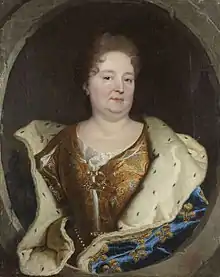
In June 1722, she visited Versailles for the last time, where the 12-year-old Louis XV had just received his 4-year-old bride Infanta Mariana Victoria of Spain; in the dying room of Louis XIV she came to tears:
So I must admit that I cannot get used to seeing nothing but children everywhere and nowhere the great king whom I loved so dearly.
— Liselotte von der Pfalz: Letter to Christian Friedrich von Harling from 4 July 1722.[132]
Elisabeth Charlotte of the Palatinate, Duchess of Orléans, died on 8 December 1722 at 3:30 a.m. at the Château de Saint-Cloud, aged 70. She was buried in the royal necropolis at the Basilica of Saint-Denis, next to her husband and his first wife. Her son mourned her deeply (only a year later he follow her to the grave), and he didn't take part in the memorial mass on 18 March 1723. In the funeral sermon she was described as follows:
...I don't know anyone who was so proud and generous and yet by no means haughty; I don't know anyone who was so engaging and amiable and yet by no means slack and powerless; a special mixture of Germanic size and French sociability made itself known, demanded admiration. Everything about her was dignity, but graceful dignity. Everything natural, unsophisticated and not practiced. She felt what she was and she let the others feel it. But she felt it without arrogance and let the others feel it without contempt.
In his memoirs, Saint-Simon describe her:
...strong, courageous, German through and through, open and downright, good and charitable, noble and great in all her demeanor, but extremely petty as to the respect she deserves...
The Letters
Liselottes' numerous letters established her fame. She is said to have written an estimated 60,000 letters all together, 2/3 in German and 1/3 in French, of which about 5,000 have survived,[133] of which about 850 are in French. With this she surpasses the second great letter writer and contemporary witness of her epoch, Madame de Sévigné with her approximately 1,200 received letters.
The letters deal with all areas of life, they contain vivid descriptions of court life in relentless openness and often in a mocking, satirical tone, as well as numerous reminiscences of her childhood and youth in Germany, the latest court gossip from all over Europe, which she often commented on in a witty tone, reflections on literature and theater, about God and the world; the letters always fascinate with their linguistic freshness. Every day Liselotte sought relief by writing long letters to her relatives in Germany, and the constant exchange became a cure for her inner melancholy and sadness, that she was exposed to through her depressing life experiences. Maintaining the German language, also by reading books, meant a piece of home and identity for her in a foreign country.
Her German letters were mixed with numerous French words and whole passages in French, for example when she replays conversations with Louis XIV, with her husband Philippe or other people. Johannes Kramer describes her letters as "the best studied example of the use of the German language in private letters between members of the high nobility".[134] Liselotte tended to use coarse formulations, which was not uncommon in letters from princely persons of the 16th and 17th centuries, but in Helmuth Kiesel's view she had gone extraordinarily far in this, including a psychological disposition, the frivolous tone in the Palais Royal and perhaps her previously reformed faith had contributed to polemics known to her; in any case, their tone differed greatly from the Précieuses of the Parisian salons of their time, and also from the naturalness of the German bourgeois lettering style of the 18th century, as shaped by Christian Fürchtegott Gellert.[135] She liked to draw striking comparisons and often interwoven proverbs or appropriate sentences from plays. Her favorite saying (and personal motto) is often quoted: "What cannot be changed, let go as it goes" (Was nicht zu ändern stehet, laß gehen wie es gehet)
Unlike Madame de Sévigné, she didn't write for the public of a small circle, but only to the respective correspondent, in concrete response to his last letter, which explains the almost unbridled spontaneity and unrestricted intimacy of the style. She didn't want to write a high style, not even romanesque, but natural, coulant, without restrictions, above all without ceremonial ado: writing comfortably is better than correct. The letters often appear to have no disposition and are subject to spontaneous ideas, whereby they make the reader a living companion (W. L. Holland).
Most of the letters received are addressed to her aunt Sophia of the Palatinate, Electress of Hanover, who wrote them twice a week. The strong personality of this aunt offered her support in all difficult life situations; Liselotte had also shaped the atmosphere of the Hanoverian court with her scientific and literary interest, her religious tolerance thinking and the preservation of morality and concepts of virtue with all due consideration for human inadequacies, for life. After Sophia's death in 1714 she complains:
This dear Electress was all my consolation in all the disparaging things, when it happened to me so often; whom my loved ones complained and wrote against received from them, I was consoled against utterly.
— Liselotte von der Pfalz: Letter to her half-sister Raugräfin Luise from 14 July 1714.[136]
Sophia, however, who had been of a cooler and more calculating nature than her emotional niece, had commented on her letters:
Madame may write a long brif, but there is not usually a lot of important written in it...
— Letter from Duchess Sophia of Hanover to her niece Raugräfin Caroline from 16 August 1687.[137]
Liselotte's half-sister Raugräfin Luise (1661–1733) subsequently became an inadequate replacement for the revered and admired aunt. She had also written regularly to another half-sister, Raugräfin Amalie Elisabeth (Ameliese; 1663–1709). She also kept a lifelong contact with her Hanoverian educator Anna Katharina von Offen, the governess of the Electress Sophia's children, and with her husband, the chief stable master Christian Friedrich von Harling.
Her weekly (French) letters to her daughter, the Duchess of Lorraine were destroyed in a fire on 4 January 1719 at the Château de Lunéville, the country residence of the Dukes of Lorraine. In the late period, the wife of the British heir to the throne and later King George II, Caroline of Ansbach, also became an important correspondent, although they never met; she was an orphan who became a ward of Electress Sophia's daughter Sophia Charlotte of Hanover and was married by Sophia to her grandson George in 1705. From her Liselotte learned all the details about the family quarrel at the English court. She also wrote regularly with the sister of George II and granddaughter of the Electress Sophia, the Prussian Queen Sophia Dorothea of Hanover. Numerous letters to other relatives and acquaintances have also been received, including to Anthony Ulrich, Duke of Brunswick-Wolfenbüttel and his librarian Gottfried Wilhelm Leibniz, who had previously been in the service of Sophia and her husband for a long time.
Her most frank letters are those which she did not send by post, but which she was able to give to travelers to Germany. In letters like this she doesn't mince her words and vent her heart when Monsieur's favorites in the Palais Royal tyrannize her or the hatred she had for Madame de Maintenon. She knew that the Cabinet noir opened her letters to copy critical passages and translate them; hence, she sometimes even incorporated derisive remarks addressed directly to the government, particularly to her favorite enemy, Foreign Secretary Jean-Baptiste Colbert, Marquess of Torcy.[138]
She describes her stylistic principles in a letter to her half-sister Ameliese:
Just continue, always naturally and without writing abruptly! Because I can't take compliments at all. God wish you could write me something so that I could make me laugh!...The stupidest people in the world can keep a compliment and write, but talking about everything and having a coulant style is rarer than you think...
— Liselotte von der Pfalz: Letter to her half-sister Raugräfin Ameliese from 6 February 1699.[139]
In her letters, Liselotte also mentioned her dislike for the pompous Baroque style that had become fashionable:
I think everything in Germany has changed so much that I'm in France that it feels like another world. I've seen letters...so I struggle to understand. In my day it was thought to be written when the phrases were briefly understood and you said a lot in a few words, but now you think it's nice when you put a lot of words around them that mean nothing. I do not care, but thank God all those with whom I correspond have not accepted this disgusting fashion; I could not have answered...
— Liselotte von der Pfalz: Letter to Christian Friedrich von Harling from 22 June 1721.[140]
To characterize the nature of her correspondence, she uses the term “chat”: for the duration of a letter (which usually consisted of 15 to 30 folded sheets of gilt edging, which she described with large, energetic handwriting), she lingered in her mind those she liked, but who lived far away to talk to them casually. Her biographer Dirk Van der Cruysse says: "Had Madame lived in our time, she would have spent her days on the phone".[141] But thanks to her letters we have a unique panorama of court life in the Baroque period and a vivid picture of her personality (and many others) have been preserved. Their descriptions are often less precise, but much more colorful and humorous than those of the Marquis de Dangeau, whose court diary and memoirs made him the official chronicler of the reign of Louis XIV. Nevertheless, she wrote without literary ambitions and not for posterity either: "I write as I speak; because I am too natural to write before I think about it. After answering, she burned the letters she received herself, and probably assumed that the same thing happened to her letters; Fortunately, just under a tenth escaped this".
Nature and appearance
Liselotte was described as stolid and mannish. She possessed the stamina to hunt all day, refusing to wear the mask that Frenchwomen were accustomed to use to protect their skin while watching their men hunt. Her face developed a ruddy and weather-beaten look. She walked too rapidly for most courtiers to keep up, save the king. She had a "no-nonsense" attitude. Her hearty appetite caused her to gain weight as the years went by, and when describing herself she once commented that she would be as good to eat as a roasted suckling pig. Raised a Protestant, she was not fond of lengthy Latin masses. She remained virtuous and at times outraged by the open infidelity practised by the aristocracy. Her views were frequently the opposite of those prevalent at the French court.[142]
She is known by different names and styles in different languages with:
- Variations of her given names, such as Charlotte Elisabeth, Elisabeth Charlotte and Liselotte von der Pfalz
- Variations of her titles and territorial designations, such as Electoral Princess, Princess Palatine, of the Palatinate, of the Rhine, "the Palatine", etc. (also in respective forms in French and German)
The dynastic titles to which she was entitled were Countess Palatine of the Rhine at Simmern and Duchess of Bavaria. At the royal court of France she was known, prior to marriage, as the Princess Palatine Elisabeth Charlotte, and afterwards, although her official title was "Her Royal Highness, Madame, Duchess of Orléans", she was entitled to and invariably accorded the unique designation of Madame as wife of the king's younger brother.[2]
Quotes
...I've been ugly in my life, so I couldn't take the pleasure of looking at my bearcat monkey face in the mirror, so it's no wonder that I haven't looked at myself often.
— Liselotte von der Pfalz: In a letter of 26 October 1704 to her aunt Sophia of Hannover.[143]I have not found (my daughter) changed much, but her master (husband) is abhorrent. Before this he was with the most beautiful colors, and now he is completely reddish brown and thicker than my son; I can say that they have children as fat as I am.
— Liselotte von der Pfalz: Letter of 20 February 1718 to her half-sister Raugräfin Luise.[144]...If it is true that you become a virgin again if you have not slept with a man for long years, then I must have become a virgin again, because since 17 years ago my lord and I did not sleep with each other, but we liked each other, knowing it will not fall into the hands of the gentlemen Tatars. The Tatars have to hold more of the feeling than of the face in the 5 senses because they prefer old women to young women...
— Liselotte von der Pfalz: In a letter of 15 May 1695 to her aunt Sophia of Hannover.[145]... How I (as a child) in the Hague with IL (my beloved, what is meant is the later English King William III of England) and met verlöff met verlöff —in Low German: "mit Verlaub" (with all due respect)— in mein hembt schiß (my dutch shit), I thought he would become in such a great figure one day; if only his big hits are not sealed like I sealed our games back then; but if it were to happen and peace would come about as a result, I would really want to be satisfied...
— Liselotte von der Pfalz: In a letter of 8 October 1688 to her aunt Sophia of Hannover, when William of Orange was preparing to overthrow his pro-French father-in-law, King James II of England.[146]...for it has been known to me all my life to be a woman, and to be Elector, forbid me to tell the truth, better to be aware than to be Madame; but if god's sake didn't know, it is unnecessary to bear in mind...
— Liselotte von der Pfalz: In a letter from 15 May 1701.[147]I would prefer to be a rich ruling imperial count with his freedom, rather than a fils de France (royal prince of France), for we are nothing but crowned slaves; I would be suffocated if I hadn't said this...
— Liselotte von der Pfalz: In a letter of 17 August 1710 to her aunt Sophia of Hannover.[148]...that makes me bleed heartily, and if you still think I'm sick that I'm sad about it...
— Liselotte von der Pfalz: In a letter of 10 November 1688 to her aunt Sophia of Hannover about the destruction of Mannheim by the French army.[149]...I believe that M. de Louvois burns in hell because of the Palatinate; he was terribly cruel, nothing could complain...
— Liselotte von der Pfalz: In a letter of 28 January 1708 to her aunt Sophia of Hannover about the French Secretary of State for War, Marquis de Louvois.[121]As EL now describe the German court to me, I would find a big change in it; I think more of sincerity than of magnificence, and I am quite happy to hear that such is lost in homeland. It is easy to see what the luxe chases away the good-heartedness from; you cannot be magnificant without money, and if you ask so much about money you become interested, and once you become interested you seek out all the means to get something, which then breaks down falsehood, lies and deceit, which then faith and sincerity quite chased away.
— Liselotte von der Pfalz: In a letter of 1 May 1692 to her aunt Sophia of Hanover.[86]I have no ambition, I don't want to rule anything, I wouldn't find any pleasure in it. This is some (own) thing for french women; no kitchen maid here believes that she has insufficient understanding to rule the whole kingdom and that she is being done the greatest injustice in the world not to consult her. All of that made me feel very sorry about ambition; for I find such a hideous ridicul in this that I dread it.
— Liselotte von der Pfalz: In a letter of 9 July 1719 to her half-sister half-sister Raugräfin Luise.[150]...there are a lot of royal persons, if one has been brought up badly and spoiled in youth, only learned their grandeur for them, but not because they are only people like others and cannot be valued with all their grandeur, if they are have no good temper and strive for virtue. I once read in a book that they are compared to pigs with gold collars. That struck me and made me laugh, but that's not bad...
— Liselotte von der Pfalz: In a letter of 19 November 1719 to her half-sister Raugräfin Luise.[151]I cannot live without doing nothing; I can still go crazy without chatting at all times would be unbearable for me...I can't read all the time either, my brain is too confused ... writing amuses me and gives my sad thoughts distraction. So I will not break off any of my correspondence, and whatever you may say, dear Luise, I will write to you all on Thursdays and Saturdays and to my dear Princess of Wales all Tuesday and Friday. I love writing; for me is a real pleasure to read and answer writing; that diverts me more than the spectacular...My smallest letter, as I write in the whole week, is to the Queen of Spain...and it gives me more trouble than any other letter ... I stay than compliments must answer, which I have never been able to take ... It could easily be that the Princess of Wales could be content to have my silly letters only once a week and to write only once; but that doesn't suit me at all, so I'll continue as I've done so far.
— Liselotte von der Pfalz: In a letter of 13 March 1721 to her half-sister Raugräfin Luise.[152]This morning I find out that the old Maintenon died, yesterday evening between 4 and 5 o'clock. It would be very lucky if it happened 30 years ago...
— Liselotte von der Pfalz: In a letter of 16 April 1719 to her half-sister Raugräfin Luise.[130]Believe me, dear Luise! The only difference between the Christian religions is that they are preachers, whatever they may be, Catholic, Reformed or Lutheran, they all have ambitions and all Christians want to make one another hate because of their religion, so that they may be needed and they may rule over people. But true Christians, if God has done the grace to love him and virtue, do not turn to the priesthood, they follow God's word as well as they understand it, and the order of the churches in which they find themselves leave that constraint to the priests, superstitions to the mob and serve their god in their hearts and seek not to give anybody offense. This is as far as God is concerned, on the whole you have no hatred of your negatives, whatever religion he may be, seek to serve him where you can, and surrender entirely to divine providence.
— Liselotte von der Pfalz: In a letter of 30 June 1718 to her half-sister Raugräfin Luise.[153]If one were not persuaded that everything was planned and not to end, one would have to live in constant agony and always think that one had to reproach oneself for something; but as soon as one sees that God Almighty has foreseen everything and nothing history, as what has been ordained by God for so long and at all times, one must be patient in everything and one can be satisfied with oneself at all times, if, what one does, in good opinion history; the rest is not with us.
— Liselotte von der Pfalz: In a letter of 25 June 1695 to her half-sister Raugräfin Luise.[154]
Legacy
In 1788, some longer excerpts from Liselotte's letters appeared for the first time –under unexplained circumstances– initially in a French translation, then a few years later in the German original, under the title Anecdotes from the French Court, especially from the times of Louis XIV and the Duke Regent. During the French Revolution, it was believed that Liselotte was a key witness to the depravity and frivolity of the Ancien Régime. This Chronique scandaleuse was all more popular in Germany when the editors of the letters succeeded in identifying the author as an honest and morally thinking German, portraying the princess in the midst of the depraved and frivolous French court life, especially since she herself had always demonstrated her German character towards the French courtiers.[155] In her aversion to the French way of life (and cuisine!), in her enthusiasm for everything German (and especially Palatinate), she followed not only personal preferences but also the pattern of anti-French sentiment in German literature of the 17th century. Even after 40 years in France, when she wrote “with us” she always meant her old home.
In 1791 a new, anonymously edited selection of letters appeared under the title "Confessions of Princess Elisabeth Charlotte of Orléans". The good, honest, German woman –without all the pampered and creeping court sensibilities, without all the crookedness and ambiguity of the heart– was portrayed as the representative of the old German, honest times of earlier centuries, to which the German courts had to return when a revolution should be prevented in Germany. The Duchess of Orléans thus became a figure of considerable cultural patriotic importance.
Friedrich Karl Julius Schütz published a new selection of the letters in 1820, he too emphasized the "strong contrast between the truly old German simplicity, loyalty, honesty and efficiency...to the glamour, opulence, etiquette and gallantry, such as the unlimited intriguing spirit and the whole, systematically developed frivolity and hypocrisy of this court, for a full half a century." In contrast to the anonymous publisher of the "Confessions" of 1791, however, Schütz appeared to be so far removed from that moral corruption that all anti-court declamations by the liberals deprived of any authorization; but not all German writers of the time, such as in the The Hessian Courier, shared this point of view.
"In the further course of the 19th century, the letters lost their immediate political relevance, but because of their cultural and historical significance and their German usability, they found equally committed editors and a broad public."[156] Also Wolfgang Menzel, who in 1843 found a volume of letters published by the half-sister Raugräfin Luise, saw in the Duchess of Orléans the simple German woman and the most open soul in the world, who only had to watch too much moral corruption... understandable that she sometimes expresses herself about it in the crudest words. From then on, the letters were gladly used in the anti-French demeanor of increasing German nationalism. Liselotte was stylized as a martyr of the French court and elevated to a national cult figure, for example in Paul Heyse's play Elisabeth Charlotte from 1864. Theodor Schott and Eduard Bodemann also followed these beliefs. However, the historicism also recognized the enormous cultural-historical value of the letters and extensive editing activities began in the editions of Bodemann and Wilhelm Ludwig Holland.
Fashion
The so-called palatine is named after Liselotte; is a short cape or turn-down collar trimmed with fur, which women use to protect the cleavage and neck from the cold in winter. Originally, she was laughed at at the French court because of her "old" furs that she wore when she arrived from Heidelberg, but since she was very popular with the king in the 1670s, the ladies began to and imitated this trend in the unusually cold winter of 1676.[157] The result was a womenswear item valued for centuries.
When Liselotte wanted to put on her old fur again in November 1718 to see a performance of Voltaire's Oedipus, to which she was dedicated, she found that it had been eaten by clothes moths. But she took the opportunity to examine the moths under the microscope the next day.[158]
Popular culture
- 1932: Liselott - Singspiel by Richard Keßler, music by Eduard Künneke, performed in Heidelberg in 2004–2005.
- 1935: Liselotte von der Pfalz - UFA film, director and screenplay: Carl Froelich, literary source: Rudolf Presber. Liselotte was played by Renate Müller.
- 1943: Liselotte - Ein Roman aus dem Leben der Elisabeth Charlotte von der Pfalz (Liselotte - A novel from the life of Elisabeth Charlotte von der Pfalz). Alexander Freiherr von Ungern-Sternberg, A. Weichert Verlag Berlin
- 1966: Liselotte von der Pfalz - Director: Kurt Hoffmann. Liselotte was played by Heidelinde Weis
- 2014: A Little Chaos - British film, directed by Alan Rickman. Liselotte was played by Paula Paul.
- 2017–2018: Versailles - BBC series. Liselotte was played by Jessica Clark.

Titles and styles
- 27 May 1652 – 16 November 1671: Her Serene Highness Princess Palatine Elisabeth Charlotte,[2] Countess Palatine of Simmern;
- 16 November 1671 – 9 June 1701: Her Royal Highness The Duchess of Orléans;[2]
- 9 June 1701 – 8 December 1722: Her Royal Highness The Dowager Duchess of Orléans.
Ancestry
| Ancestors of Elizabeth Charlotte, Madame Palatine |
|---|
Notes
- Paas 1996, p. 92.
- Spanheim, Ezechiel (1973). Le Temps retrouvé XXVI: Relation de la Cour de France. Paris, France: Mercure de France. pp. 74–79, 305–308.
- Van der Cruysse 2001, p. 229.
- Paas 1996, pp. 33–34.
- Van der Cruysse 2001, p. 66.
- Van der Cruysse 2001, p. 64.
- Van der Cruysse 2001, pp. 39–61.
- Van der Cruysse 2001, p. 103.
- Van der Cruysse 2001, p. 252.
- Van der Cruysse 2001, pp. 349–350.
- Paas 1996, pp. 65–67.
- Van der Cruysse 2001, pp. 52–58.
- Van der Cruysse 2001, pp. 67–68.
- Van der Cruysse 2001, pp. 68–73.
- Van der Cruysse 2001, p. 92.
- Paas 1996, pp. 52–59.
- Van der Cruysse 2001, pp. 76–81.
- Van der Cruysse 2001, p. 89.
- Van der Cruysse 2001, p. 77.
- Van der Cruysse 2001, p. 79.
- Van der Cruysse 2001, pp. 82–83.
- Van der Cruysse 2001, p. 90.
- Van der Cruysse 2001, p. 88.
- Van der Cruysse 2001, pp. 94–95.
- Van der Cruysse 2001, pp. 98–99.
- Van der Cruysse 2001, pp. 84–85.
- Van der Cruysse 2001, p. 99.
- In a letter to Electress Sophia of Hanover dated 23 May 1709, Liselotte describes a conversation with her confessor, who wanted to "convert" her to the veneration of saints.
- Van der Cruysse 2001, pp. 96–97.
- Van der Cruysse 2001, p. 15.
- Van der Cruysse 2001, p. 116.
- Van der Cruysse 2001, pp. 412–413.
- Van der Cruysse 2001, p. 141.
- Van der Cruysse 2001, pp. 139–140.
- Van der Cruysse 2001, pp. 142–145.
- Van der Cruysse 2001, p. 143.
- Van der Cruysse 2001, pp. 208–209.
- Van der Cruysse 2001, pp. 676–679.
- Van der Cruysse 2001, pp. 153–158.
- Van der Cruysse 2001, p. 203.
- Van der Cruysse 2001, p. 209.
- Van der Cruysse 2001, p. 453.
- Van der Cruysse 2001, p. 219.
- Van der Cruysse 2001, p. 155.
- Van der Cruysse 2001, pp. 153–202.
- The memoirs of the Duke of Saint-Simon. Ullstein, Frankfurt 1977, ISBN 3-550-07360-7, Vol. 1, p. 285.
- Ziegler 1981, pp. 64–83.
- Ziegler 1981, p. 193.
- Van der Cruysse 2001, pp. 175–180.
- Van der Cruysse 2001, p. 180.
- Van der Cruysse 2001, p. 200.
- Van der Cruysse 2001, pp. 199–200.
- Van der Cruysse 2001, pp. 198–200.
- Van der Cruysse 2001, p. 206.
- Van der Cruysse 2001, p. 679.
- Van der Cruysse 2001, p. 216.
- Quotation from a letter from La Grande Mademoiselle in: Van der Cruysse 2001, p. 146.
- Van der Cruysse 2001, pp. 208–2016.
- Van der Cruysse 2001, p. 218.
- Van der Cruysse 2001, p. 215.
- Van der Cruysse 2001, p. 204.
- Van der Cruysse 2001, p. 214.
- Van der Cruysse 2001, p. 217.
- Van der Cruysse 2001, pp. 147–148.
- Van der Cruysse 2001, p. 292.
- Secret memoirs of the court of Louis xiv, and of the regency; extracted from the German correspondence of the Duchess of Orleans, 1824
- Van der Cruysse 2001, p. 226.
- Van der Cruysse 2001, pp. 287–300.
- Van der Cruysse 2001, pp. 292–296.
- Van der Cruysse 2001, pp. 289–299.
- Kiesel 1981, p. 109.
- Ziegler 1981, p. 195.
- Van der Cruysse 2001, p. 189.
- Ziegler 1981, pp. 194–195.
- Van der Cruysse 2001, pp. 186–188.
- Ziegler 1981, p. 192.
- Van der Cruysse 2001, pp. 188–191.
- Ziegler 1981, pp. 196–197.
- Van der Cruysse 2001, p. 191.
- Van der Cruysse 2001, p. 301.
- Van der Cruysse 2001, pp. 307–308.
- Van der Cruysse 2001, p. 308.
- Van der Cruysse 2001, p. 450.
- Van der Cruysse 2001, p. 606.
- Van der Cruysse 2001, p. 335.
- Kiesel 1981, p. 91.
- Van der Cruysse 2001, pp. 324–331.
- Van der Cruysse 2001, p. 336.
- Van der Cruysse 2001, pp. 335–336.
- Van der Cruysse 2001, pp. 334–335.
- Kiesel 1981, p. 222.
- Kiesel 1981, p. 127.
- Kiesel 1981, p. 72.
- Van der Cruysse 2001, p. 364.
- Van der Cruysse 2001, pp. 354–356.
- Van der Cruysse 2001, pp. 358–368.
- Van der Cruysse 2001, pp. 364–365.
- Van der Cruysse 2001, p. 688.
- Van der Cruysse 2001, p. 367.
- Van der Cruysse 2001, pp. 382–388.
- Van der Cruysse 2001, pp. 384–385.
- Van der Cruysse 2001, p. 385.
- Van der Cruysse 2001, p. 386.
- Van der Cruysse 2001, p. 397.
- Van der Cruysse 2001, p. 404.
- Van der Cruysse 2001, p. 419.
- Van der Cruysse 2001, p. 436.
- Bodemann 1888, p. 74.
- With humor is meant the "capricious changeability" of English politics.
- Kiesel 1981, p. 132.
- Van der Cruysse 2001, p. 454.
- Van der Cruysse 2001, pp. 452–453.
- Van der Cruysse 2001, p. 457.
- Van der Cruysse 2001, p. 458.
- Van der Cruysse 2001, p. 463.
- Van der Cruysse 2001, pp. 445–452.
- Van der Cruysse 2001, p. 449.
- Van der Cruysse 2001, p. 447.
- Van der Cruysse 2001, p. 452.
- Van der Cruysse 2001, pp. 459–460.
- Kiesel 1981, p. 164.
- Kiesel 1981, p. 237.
- Van der Cruysse 2001, pp. 579–581.
- Van der Cruysse 2001, p. 581.
- Van der Cruysse 2001, p. 584.
- Kiesel 1981, p. 230.
- Kiesel 1981, p. 231.
- Kiesel 1981, p. 233.
- Kiesel 1981, p. 211.
- Kiesel 1981, p. 218.
- Van der Cruysse 2001, pp. 519–535.
- Kiesel 1981, p. 255.
- Kiesel 1981, p. 10.
- Johannes Kramer: The French in Germany. An introduction. Stuttgart 1992. p. 65.
- Kiesel 1981, p. 25.
- Holland 1867–1881, pp. 401–402.
- Bodemann 1888, p. 59.
- Van der Cruysse 2001, p. 514.
- Kiesel 1981, p. 123.
- Kiesel 1981, p. 249.
- Van der Cruysse 2001, p. 513.
- Fraser, Dame Antonia, Love and Louis XIV, Anchor Books, 2006, pp. 134, 137, 140. ISBN 9781400033744
- Paas 1996, p. 65.
- Holland 1867–1881, pp. 188–189.
- Kiesel 1981, p. 105.
- Bodemann 1891, p. 100.
- Holland 1867–1881, p. 225.
- Bodemann 1891, pp. 253–254.
- Bodemann 1891, p. 101.
- Kiesel 1981, p. 224.
- Kiesel 1981, p. 226.
- Kiesel 1981, p. 240.
- Kiesel 1981, p. 212.
- Kiesel 1981, p. 106.
- Kiesel 1981, p. 26.
- Kiesel 1981, p. 29.
- Van der Cruysse 2001, pp. 218–219.
- Van der Cruysse 2001, p. 605.
References
- Dirk Van der Cruysse: Madame sein ist ein ellendes Handwerck. Liselotte von der Pfalz. Eine deutsche Prinzessin am Hof des Sonnenkönigs. (in German) Aus dem Französischen von Inge Leipold. 7th edition, Piper, Munich 2001, ISBN 3-492-22141-6.
- Peter Fuchs (1959), "Elisabeth Charlotte", Neue Deutsche Biographie (NDB) (in German), 4, Berlin: Duncker & Humblot, pp. 448–451; (full text online)
- Arlette Lebigre: Liselotte von der Pfalz. Eine Wittelsbacherin am Hofe Ludwigs XIV. (in German). Claassen, Düsseldorf 1988, ISBN 3-453-04623-4 (reprint Heyne, Munich 1991).
- Sigrun Paas (ed.): Liselotte von der Pfalz. Madame am Hofe des Sonnenkönigs. HVA, Heidelberg 1996, ISBN 3-8253-7100-X (catalog for the exhibition in Heidelberg Castle).
- Gilette Ziegler (ed.): Der Hof Ludwigs XIV. in Augenzeugenberichten (in German), DTV publisher, 1981, ISBN 978-3423027113.
- Eduard Bodemann (ed.): Briefe der Kurfürstin Sophie von Hannover an die Raugräfinnen und Raugrafen zu Pfalz (in German), 1888, Wentworth Press 2018, ISBN 978-0270569810.
- Eduard Bodemann (ed.): Aus den Briefen der Herzogin Elisabeth Charlotte von Orléans an die Kurfürstin Sophie von Hannover (in German), 1891, hansebooks, ISBN 978-3743392069
- Helmuth Kiesel: Briefe der Liselotte von der Pfalz (in German), Insel publisher, Leipzig 1981, ISBN 3-458-32128-4.
- Marita A. Panzer: Wittelsbacherinnen. Fürstentöchter einer europäischen Dynastie. Pustet, Regensburg 2012, ISBN 978-3-7917-2419-5, pp 108–121.
- Ilona Christa Scheidle: Schreiben ist meine größte Occupation. Elisabeth Charlotte von der Pfalz, Herzogin von Orléans (1652–1722) (in German). In: Dies.: Heidelbergerinnen, die Geschichte schrieben. Munich 2006, ISBN 978-3-7205-2850-4, pp. 27–39.
- Mareike Böth: Erzählweisen des Selbst. Körper-Praktiken in den Briefen Liselottes von der Pfalz (1652–1722) (in German) (= Selbstzeugnisse der Neuzeit. vol. 24). Böhlau, Köln/Wien/Weimar 2015, ISBN 978-3-412-22459-2.
- Wilhelm Ludwig Holland: Briefe der Herzogin Elisabeth Charlotte von Orléans (in German), Stuttgart/Tübingen 1867–1881, Wentworth publisher 2018 (6 volumes) ISBN 978-0270453850
Further reading
- Life and letters of Charlotte Elisabeth, Princess Palatine and mother of Philipp d'Orléans, régent de France 1652–1722, compiled, translated, and gathered from various published and unpublished, Chapman & Hall, London, 1889.
- A woman's life in the court of the Sun King: letters of Liselotte von der Pfalz, 1652–1722, Elisabeth Charlotte, Duchesse d'Orléans, translated by Elborg Forster, Johns Hopkins University Press, 1984.
External links
| Wikimedia Commons has media related to Elisabeth Charlotte of the Palatinate. |
